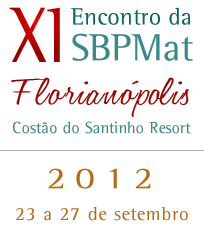Symposia
 Download
Download
Symposium K: Nanotechnology and Nanomaterials Applied to Biotechnology and Agriculture
Scope of the symposium
Nanotechnology have been influencing all the knowledge areas. The number of applications in the agriculture is increasing, from plant and animal genetic improvement, development of environmentally friendly pesticides, environmental protection with reduction of pollutant emissions by means of efficient energy conversion, transformation of agricultural residues to highly valued products among other applications, which in the near future may be achieved. The nanocatalysts development for renewable sources of energy and pollutants degradation in the water resources will be expanded with nanotechnology advances. The biosynthesis and bioprocess also provide advances for chemical and pharmaceutical products. The nanostructured sensors and biosensors improvement can evaluate the water and food quality, and monitor diseases. In order to approach the multidisciplinary nanotechnology aspects, this symposium will be an opportunity to discuss the nanomaterial applications in biotechnology and agriculture, expecting to understand the current state of development of the nanoscience and nanotechnology. This symposium for SBPMat was previously edited in 2008 and due to the valuable results achieved, this second edition for the present meeting intends to evaluate the advances of those technologies in this period, and the new upcoming researches, which will influence the scientific work in this area in the next years. This symposium has the goal of merging different areas, such as physics, chemistry, biology and engineering, to discuss the nanoscience and nanotechnology contributions for the biotechnology and agriculture applications and their environmental impacts.
Abstracts will be solicited in (but not limited to) the following topics:
Nanomaterials, nanostructures and nanocomposites from renewable sources;
Advances in bio-nanomaterials;
Bio-inspired nanomaterials;
Nanomaterials and nanostructures for environmental remediation;
Environmental impacts of nanomaterials;
Toxicology of nanomaterials and nanostructures;
Nanostructures for controlled release of drugs, agro-chemicals and others;
Sanitary aspects of nanostructures and applications in anti-microbial systems;
Nanostructured sensors for applications in food, water and environmental control;
Nanostructured biosensors;
Separation membranes and thin films for food packaging;
Reuse of agricultural residues by nanotechnology applications.
Symposium organizers
Luiz Henrique Capparelli Mattoso (Embrapa, São Carlos, SP, Brazil)
Elaine Cristina Paris (Embrapa, São Carlos, SP, Brazil)
Daniel Souza Corrêa (Embrapa, São Carlos, SP, Brazil)
Caue Ribeiro (Embrapa, São Carlos, SP, Brazil)
Invited Speakers (Confirmed)
Cleber Renato Mendonça (USP, Brazil)
Fernando Manuel Araújo (UFSCar, Brazil)
Jamshid Avloni (Eeonyx Corporation, USA)
Leonardo Giordano Paterno (UNB, Brazil)
Luiz Antonio Pessan (UFSCar, Brazil)
Raul Cavalcante Maranhão (USP, Brazil)
Tara McHugh (ARS/USDA, USA)
Members of Scientific Committee
Alberto Carlos de Campos Bernardi (Embrapa)
Alexandra Manzoli (Embrapa)
Caio Márcio Paranhos da Silva (UFSCar)
Eliton Souto de Medeiros (UFPB)
Fernando Josepetti Fonseca (USP)
Humberto Mello Brandão (Embrapa)
Ingrid Távora Weber (UnB)
José Manoel Marconcini (Embrapa)
Juliano Elvis de Oliveira (UFPB)
Maria Alice Martins (Embrapa)
Osvaldo Novais de Oliveira Júnior (USP)
Tania Regina Giraldi (Unifal)
Valdir Soldi (UFSC)
Valtencir Zucolotto (USP)
Waldir Avansi Junior (UNESP)
Tentative list of financial support for the Symposium
Embrapa, Braskem, Michelin, BASF, Corn Products, Syngenta, Vale
 Voltar
Voltar


 Programação Geral
Programação Geral


